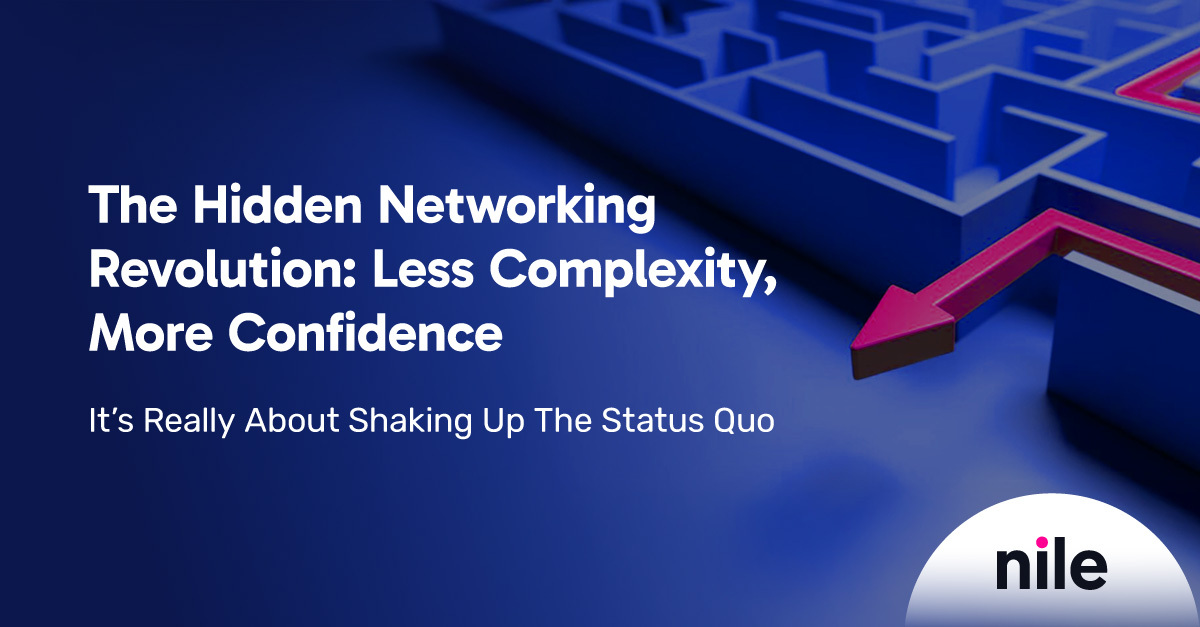Share Via
For years, organizations seeking to simplify networking have relied on Managed Service Providers (MSPs) or traditional Network as a Service (NaaS) models to simplify networking and reduce operational complexity. To some extent, these models have been effective, as they represented the best available option.
Having spent my career designing, deploying, and supporting networks across enterprises, service providers, and integrators, I’ve seen the challenges of outsourcing complexity firsthand. Traditional NaaS providers and MSPs frequently inherit the inefficiencies of legacy network designs, leaving gaps that hinder scalability, security, and simplicity.
Until recently, there wasn’t a better alternative. Now, Nile Autonomous Networking changes everything.
Nile isn’t just a new take on networking, it’s a fundamentally different approach. Instead of layering services and tools on top of outdated architecture, Nile delivers an autonomous network that eliminates the complexity altogether.
The Challenges with Managed Service Providers (MSPs)
I’ve worked with/for MSPs and have seen organizations turn to MSPs in hopes of scaling network operations more efficiently, but the traditional MSP model introduces challenges and limitations that often outweigh the benefits:
- Every Network is Unique and That’s the Problem: No two networks are the same, making it incredibly difficult for MSPs to deliver standardized, high-quality service across multiple customers. Custom support leads to high costs, longer resolution times, and inconsistent results.
- Shifting the Headache, Not Solving the Problem: I’ve observed organizations turn to outsourced network management expecting proactive solutions, but often the same underlying issues remain…only now handled by a managed provider instead of the internal IT team.
- Human Error & Complexity: MSPs depend on people to juggle multiple tools, dashboards, and manual processes…each one adding potential points of failure and inefficiency.
- Security Risks in Third-Party NOCs: In outsourced environments, it’s often unclear who owns security policies…the MSP or the customer. That ambiguity makes enforcing Zero Trust Network Access (ZTNA) challenging, increasing the risk of exposure and compliance gaps.
- Scaling Across Customers is Nearly Impossible: It’s one thing to support a single network. It’s another to maintain consistency across dozens or even hundreds of networks. Each customer has different architectures, policies, and vendors. I’ve seen firsthand how difficult this is to execute at scale.
The Challenges with Traditional Network as a Service (NaaS)
Traditional NaaS emerged to offer a more flexible way to consume networking. Unfortunately, these models still operate on legacy infrastructure and software, leading to many of the same challenges.
- Add-Ons Drive Up Costs: I’ve watched organizations adopt NaaS from a traditional vendor only to find that security, automation, and analytics all come at an additional cost. The predictable pricing they expected becomes unpredictable as add-ons accumulate.
- Hardware Ownership & Leasing Complexities: Someone still needs to own and manage the hardware, typically through a leasing model that incurs increasing costs over time. Additionally, scaling isn’t seamless; it merely shifts CAPEX to a different financial structure.
- Lifecycle Management Burden: Scheduled outages for upgrades, hoping that patches and updates don’t introduce new issues. I’ve seen this cycle play out time and again.
- Security Complexity: Because traditional NaaS models built on legacy infrastructure and management principles require multiple security tools to establish Zero Trust, this increases complexity instead of reducing it.
- Flexibility and Control is Lost: Because the NaaS provider has so many “instances” to maintain, you need to engage for the most simplistic change and it needs to be executed by the MSP to ensure execution.
- Cloud-Managed, But Not Cloud-Native: Traditional NaaS moves network management processes to the cloud, yet it doesn’t fundamentally deliver a modern network to fully leverage cloud efficiencies.
Why Nile is Different – A True Network as a Utility
This is where Nile transforms the networking industry landscape. When I first encountered Nile’s approach to autonomous networking, it became evident that this was what I had been attempting to achieve over the last 25 years… and it is what enterprises lack:
- Pre-built, fully redundant infrastructure that allows Nile to offer performance guarantees from day one
- Deterministic, cloud-native design with a limited number of SKUs, ensuring predictability and simplicity
- Real-time user experience monitoring with sensors that continuously transmit performance, capacity, and availability telemetry for service quality
- Automated software management. No more scheduled downtime, manual patches, or maintenance windows, with the post-upgrade worries
- Built-in Zero Trust with native micro-segmentation, identity-based access, and per-host isolation for granular policy enforcement
- Uninterrupted, microservices-driven upgrades that ensure networks never go offline
- Cloud-native, closed-loop autonomous networking that continuously self-optimizes
- Predictable per-user or per-square-foot pricing. No surprises, no hidden fees
- Hardware refreshes managed by Nile, removing the burden of long-term ownership or lease agreements
Make no mistake, this isn’t MSP 2.0, and it’s not just another NaaS option; it’s a fundamentally different way to consume networking that removes complexity, operational burden, and security risks from the equation.
The Bottom Line
I’ve spent years working with enterprises, service providers, and MSPs, seeing firsthand how difficult it is to manage complex networks at scale. MSPs and traditional NaaS have been effective to some extent, not because they were perfect solutions but because there were no better alternatives.
Now, there’s a smarter way forward.
With Nile, companies no longer have to accept complexity as a given. Instead of managing problems, they can eliminate them, achieving a truly autonomous, secure, and scalable network experience.
If your organization is tired of reactive troubleshooting, unpredictable costs, and operational overhead, it’s time to consider a new model for networking. Let’s talk.



